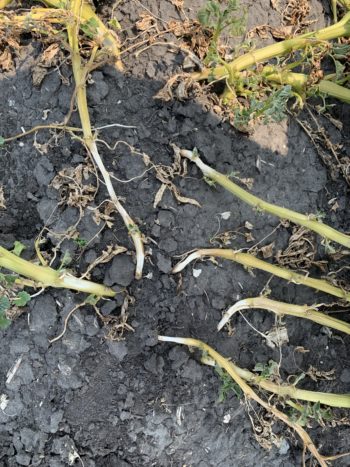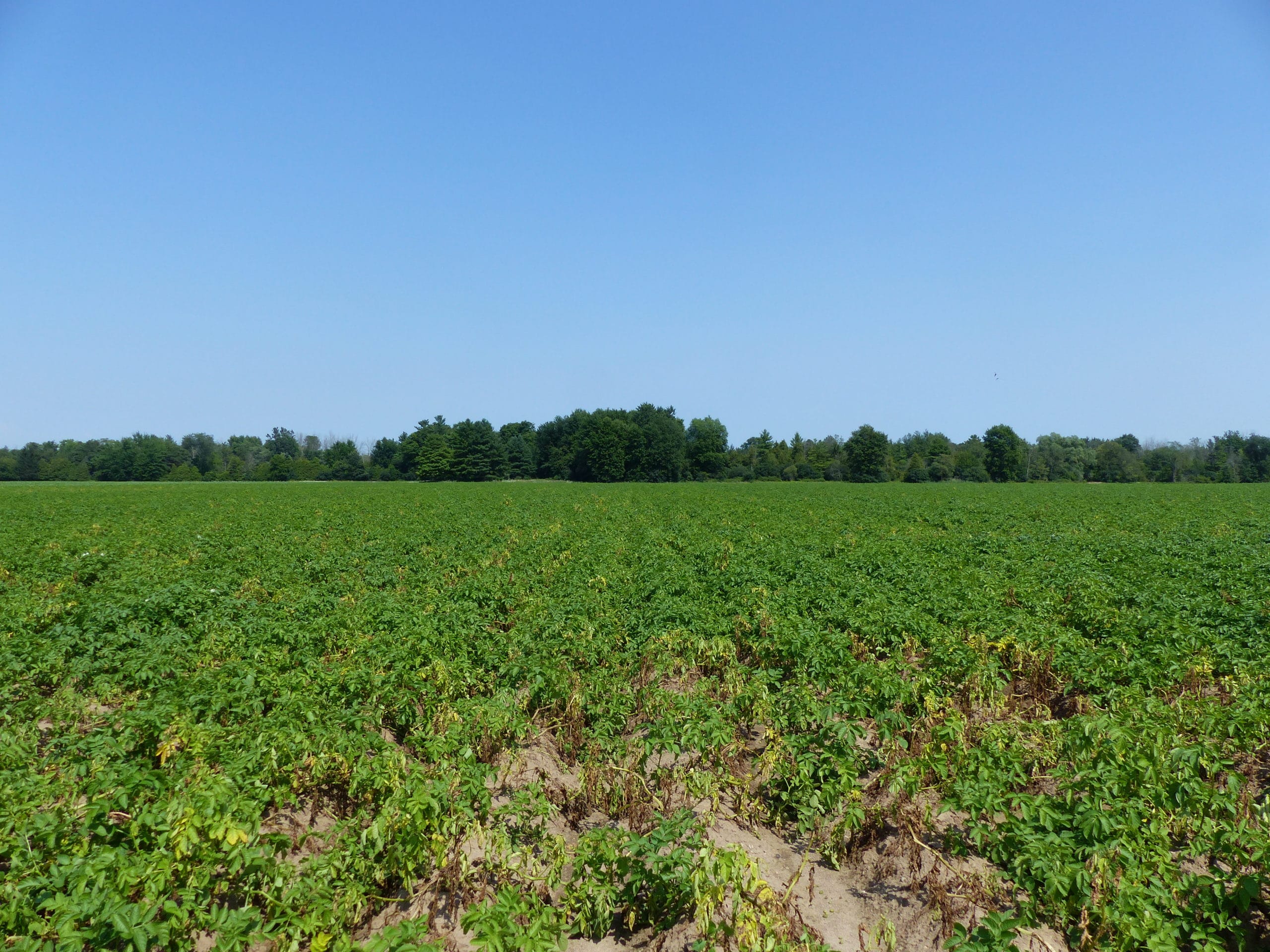Drought and extreme heat in many parts of the country over the past few years have proven to be a major challenge for many potato growers.
Entertainer and humourist Will Rogers once said a farmer has to be an optimist, or he wouldn’t still be a farmer.
That optimism has been sorely tested over the past couple of years among Canadian potato growers. Prolonged periods of insufficient rainfall combined with extreme heat and drought in many parts of the country have severely reduced yields, made some tubers more susceptible to disease and created a host of logistical challenges when it comes to storage.
“When there is insufficient soil moisture, plants can’t move water into the plant through the roots,” Ryan Barrett, research and agronomy specialist with the Prince Edward Island Potato Board, says in an email interview in early August. “This water also brings essential nutrients to support plant growth and tuber development.
“During extended periods of drought, potato plants essentially go into survival mode and tuber growth stops. If this goes on too long, plants begin to wilt and suffer from diseases like Verticillium wilt or early blight. In addition, high soil temperatures can cause physiological issues with tubers and impact the water holding capacity of the soil as well as the biological activity of the soil.”
P.E.I. Hardest Hit in Past Years
Few potato producing regions of the country have been harder hit by heat and drought in recent times than P.E.I.
The last four growing seasons prior to this year were extremely dry, especially the 2020 growing season. Central P.E.I., which has the largest acreage of potatoes in the province, experienced well below average rainfall and yields in the region were down by as much as 35 per cent in some fields. In fact, some farms saw less rain in 2020 than in 2001, which is often referred to as the last big drought in P.E.I. To make matters worse, an early frost in mid-September effectively killed a number of acres just as plants were getting ready to bulk up. The one positive was quality remained relatively high.
The good news, according to Barrett, is the situation appears to be much more positive this year. Most areas of the province saw average or above average rainfall through June and July and Barrett says the majority of acres “look terrific” with full canopy achieved 10 to 14 days ahead of schedule and tuber initiation also ahead of schedule.
“The number of tubers per plant is well above average for most varieties and soil moisture levels continue to be good, so there is a strong chance at an above-average crop. Hopefully the weather in August and September makes that a reality,” he adds.
Eerily Similar Conditions Plague Western Canada
The situation in Manitoba this summer was eerily similar to the one P.E.I. experienced a year ago. The Prairie province suffered one of the driest summers ever in 2021 with some regions, including Winnipeg, receiving the lowest amount of precipitation on record for the month of July.

Vikram Bisht, of the Manitoba Department of Agriculture and Resource Development, says potato growing regions in the province received between 40 and 60 per cent of normal precipitation levels by early August of this year.
Compounding the problem was the number of days during which temperatures climbed to above 30 C. Bisht said that kind of extreme heat often leads to plants undergoing secondary sprouting with two or three generations of tubers in the same plant which in turn reduces the uniformity of potatoes that processors like.
Further complicating the situation in Manitoba was the fact many of the streams and retention ponds growers would normally use to irrigate their crops were at 25 to 50 per cent of normal capacity this summer. Rivers were so low in some areas, the water allocation for irrigation had to be reduced, added Bisht, an industry development specialist in potato and horticulture crops pathology.
Bisht says the situation in Manitoba could turn around if the province were to have a few good rainfall events but cautioned the soil moisture profile in most potato growing regions of the province remained extremely dry in mid-August. Some dryland potato fields may not be able to turn around much even with a good rain, he adds.
Back to Normal for Growers in Ontario
Potato growers in Ontario have had to deal with extreme heat and dry conditions for much of the past three years. Last season was shaping up to be a below-average year for yield until some much-needed rain arrived in late summer.
This year is looking more promising, especially in the Shelburne and Alliston areas where planting took place in May and fields flowered right on schedule. Some late June rains and perfect potato weather in July means drought won’t be a concern for most producers, says Eugenia Banks, a potato specialist for the Ontario Potato Board.
That’s good news for growers in those regions, since the tuberization process can be inhibited by severe heat and below normal precipitation and can prevent tubers from sizing up properly, Banks explained. The more normal growing conditions also mean that potato plants are less susceptible to diseases like Black Dot or Verticillium. Heat or drought stress makes crops more prone to those diseases, she adds.
Harvest Time Brings Challenges
With harvest about to begin or already in full swing in most parts of the country, Banks says its important growers be aware of soil conditions and temperature before they start harvesting. One of the most important considerations, she says, is to harvest when the daytime temperatures are not too warm. She recommends harvesting when temperatures are 25 C or lower so that pulp temperatures are between 11 C and 18 C when they go into storage. This greatly reduces the risk of the tubers developing soft rot or Pythium leak.
Peter VanderZaag, who co-owns Sunrise Potato near Alliston, Ont. with his daughter Ruth and son-in-law Nick Ploeg, recommends growers conduct sucrose testing prior to harvesting. He said if sucrose levels are too high prior to top killing, growers can still store the potatoes, but they won’t make for a good finished processed product.
“We always do sucrose testing in the middle of August to see how the tubers are doing biochemically. Based on that we decide when to top kill,” he explains.
Barrett recommends growers be especially vigilant for signs of dark or jelly end rot, which typically develops because of high temperatures and water stress, prior to placing any potatoes into storage. If rot is detected, he says it’s recommended growers increase airflow in their storage units to dry up any at-risk tubers and eliminate free moisture in the pile.
Looking Ahead to Future Growing Seasons
With declining rainfall totals and rising temperatures across the country, what impact might this have on potato production in the coming years? While it’s too early to say with any certainty, it’s leading some growers to reexamine how they go about their business.
VanderZaag said he and many growers he knows have already started looking at different varieties of potatoes that are better suited to grow in those conditions.
“Oh, absolutely,” he says. “We’re getting smarter about eliminating varieties that are susceptible to these malformations of tubers and those that have a better roots system and better control of water loss through the somata during drought stress.”
If rainfall totals continue to trend downward and temperatures continue to climb, potato producers may be forced to reconsider some current agronomic practices, Bisht warns. He says some growers have already started adopting new techniques, such as narrowing spacing between rows, from the traditional 36-inch spacing to 34 or even 32 inches. This helps plants to cover hills much quicker and reduce the amount of heat those hills must absorb.
“The agronomy is going to have to change,” he said. “That is something the growers can manage. Everything else depends on nature.”
Related Articles
Weather Driving Canadian Potato Crop Outlook
StatsCan Pegs Western Canada Drought as Bad as 2002 in Some Areas









